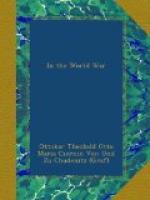“Wool 17 per cent., cotton 27 per cent., flax 38 per cent., hemp 48 per cent., jute 74 per cent., woollen materials 83 per cent., copper and copper ore 49 per cent., iron and steel 59 per cent. As to the imports of iron ore I will give more detailed figures:
“Coffee 66 per cent., tea 41 per cent., raw sugar 10 per cent., refined sugar 90 per cent., bacon 17 per cent., butter 21 per cent., lard 21 per cent., eggs 39 per cent., timber 42 per cent.
“The only increases worth noting are in the case of leather, hides, rubber and tin.
“As regards the group in which we are most interested, the various sorts of grain, no figures for quantities have been given from February onwards.
“The mere juxtaposition of two comparable values naturally gives no complete idea of the facts. It should be borne in mind that the commencement of the unrestricted U-boat campaign came at a time when the economical position of England was not normal, but greatly weakened already by two and a half years of war. A correct judgment will, then, only be possible when we take into consideration the entire development of the imports during the course of the war.
“I will here give only the most important figures.
“In the case of iron ore, England has up to now maintained its position better than in other respects.
“Imports amounted in 1913 to 7.4 million tons.
“In 1916 to 6.9 million tons.
“January, 1913, 689,000 tons; February, 1913, 658,000 tons.
“January, 1916, 526,000 tons; February, 1916, 404,000 tons.
“January, 1917, 512,000 tons; February, 1917, 508,000 tons.
“Here again comparison with the peace year 1913 shows for the months of January and February a not inconsiderable decrease, though the imports, especially in February, 1917, were in excess of those for the same month in 1916.
“Timber imports, 1913, 10.1 million
loads.
" " 1916,
5.9 " "
" February, 1913,
406,000 loads.
" " 1916,
286,000 "
" " 1917,
167,000 "
“As regards mining timber especially, the import of which fell from 3.5 million loads in 1913 to 2.0 million in 1916, we have here December, 1916, and January, 1917, with 102,000 and 107,000 loads as the lowest import figures given since the beginning of 1913; a statement for the import of mining timber is missing for February.
“Before turning to the import of foodstuffs a word may be said as to the export of coal.
“The total export of coal has decreased from 78 million tons in 1913 to 461/2 million tons in 1915; in 1916 only about 42 million tons were exported. In December, 1916, the export quantity fell for the first time below 3 million tons, having remained between 3.2 and 3.9 million tons during the months from January to November, 1916. In January, 1917, a figure of 3.5 million tons was again reached; it is the more




